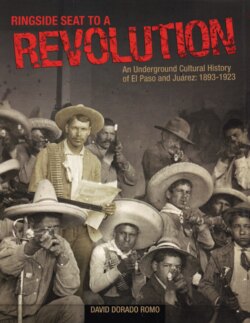Читать книгу Ringside Seat to a Revolution - David Dorado Romo - Страница 52
На сайте Литреса книга снята с продажи.
Оглавлениеbusinessmen to buy shares in the International Airship Company of Paterson, New Jersey, which
he founded to sell his flying contraptions.
In May 1909, the New York Times reported that Victor Ochoa entered his Ornithopter in an
Arlington, New Jersey, aerial carnival.103 The Aero Club of America promised $1,000 as a prize
for the best-designed flying machine that could stay in the air for more than a mile. Ochoa’s fly-
ing contraption had six aluminum wings folded back like a bird’s—they were mounted on two
bicycle frames. It had a six-horsepower gasoline motor connected to large magnets that made its
wings oscillate like a bumble bee. (His earliest version of the flying machine was propelled by
clockwork.) The Ornithopter was an example of turn-of-the-century rasquachismo at its best—
brash, shoddy, makeshift, ambitious, even a bit comical, but with definite flashes of brilliance.104
Before the aerial carnival, Victor told that press that his craft would take him to Chicago and
back in 18 hours. The Ornithopter didn’t fly. But this small detail didn’t stop him from making
other predictions. He prophesied that some day flying machines would reach up to 300 miles an
hour. “The airship of the future bound on a long journey will rise to the proper height,” Ochoa
announced, “and will fly around the earth or half or quarter the way around it—regardless of
conditions in the atmosphere below.”105 Ochoa added that once he perfected his winged
machine he would start “an aerial transportation company and carry passengers and freight from
New York to San Francisco.”106 According to his calculations, to carry one passenger from one
of these cities to the other would cost him about $1 one way.
Victor also developed an “aeromobile”—part truck, part biplane—which he called the
“Ochoaplane.” It weighed 800 pounds and had pneumatic tires and wings that could be folded
back, allowing the owner to store it conveniently in a barn or garage. It had a propeller in the
front rather than the back like most of the other flying machines at the time. For several years
he experimented with a steam turbine, a steam boiler, a flash condenser, a 630-watt dynamo and
an 80-horsepower gasoline motor but none of them got his aeromobile off the ground.
On Monday November 8, 1909, the Paterson Evening News reported that Ochoa assured the
public that this time the Ochoaplane would “fly around City Hall a few times.”
The news of the attempted flight soon spread around town and hundreds of the curious
gathered at the park and waited for hours to see the fun. The day was an ideal one for
just such experiments. There was the greatest suspense and after a tedious delay Mr.
Ochoa climbed into the rigging and announced he was ready. The motor was started and
the curious looking affair whirled around the track at a dizzy rate. The spectators had the
time of their lives keeping out of the way of the flying contrivance. Those who attend-
ed the exhibition received a plentiful supply of dust. During the experiment the machine
did not leave the ground. Mr. Ochoa was not discouraged and said that he would rem-
edy the trouble during the week and will surely fly in the course of a few days.107
103
“Aerial Carnival for High Flyers,” New York Times, May 23, 1909.
104
The concept of “rasquachismo” is usually employed by Chicano scholars to define the makeshift aesthetic sensibility of
Mexican American artists, but in this case it’s appropriate for a Mexican American inventor as well. For a more complete
definition of rasquachismo, see Tomas Ybarra-Frausto’s essay “Rasquachismo: A Chicano Sensibility” in Chicano Art:
Resistance and Affirmation (Los Angeles: UCLA, 1991) pg. 155-162.
105
“Victor Ochoa,” column by Virginia Turner, (no date) Victor L. Ochoa Papers, National Museum of American History.
106
Fly Time Over in New Jersey,” Paterson Evening News, May 1909, Victor. L. Ochoa Papers.
107
Paterson Evening News, November 8, 1909.
47
